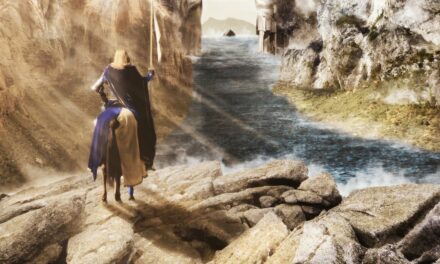We support our Publishers and Content Creators. You can view this story on their website by CLICKING HERE.
The extreme improbability of the “very perfectly precise” conditions needed for a sustainable universe capable of sustaining life within it was calculated by Oxford mathematician-physicist Roger Penrose in 1989. The number that Penrose calculated with respect to the conditions necessary for sustaining life is astronomical.
 At the beginning of his book, Science at the Doorstep to God, Father Robert Spitzer presents statistical data showing that scientists are much more likely to believe in God today than was the case a century or so ago. Sir Fred Hoyle, father of the theory of stellar nucleosynthesis, is typical of the shift of scientists from disbelief to belief. He had been an atheist for decades until new scientific discoveries called his atheism into question. Specifically, his atheism was shaken to its very foundations by his discovery that extremely precise fine-tuning was required in the resonance levels of oxygen, carbon, helium and beryllium for carbon bonding and carbon abundance to be possible. Such precision was so unlikely to be possible by chance that he saw no option but to believe in God:
At the beginning of his book, Science at the Doorstep to God, Father Robert Spitzer presents statistical data showing that scientists are much more likely to believe in God today than was the case a century or so ago. Sir Fred Hoyle, father of the theory of stellar nucleosynthesis, is typical of the shift of scientists from disbelief to belief. He had been an atheist for decades until new scientific discoveries called his atheism into question. Specifically, his atheism was shaken to its very foundations by his discovery that extremely precise fine-tuning was required in the resonance levels of oxygen, carbon, helium and beryllium for carbon bonding and carbon abundance to be possible. Such precision was so unlikely to be possible by chance that he saw no option but to believe in God:
Would you not say to yourself, “Some super-calculating intellect must have designed the properties of the carbon atom, otherwise the chance of my finding such an atom through the blind forces of nature would be utterly miniscule.” A commonsense interpretation of the facts suggests that a superintellect has monkeyed with physics, as well as with chemistry and biology, and that there are no blind forces worth speaking about in nature. The numbers one calculates from the facts seem to me so overwhelming as to put the conclusion almost beyond question.[1]
Sir Fred Hoyle’s conviction that the fine-tuning of the cosmos pointed to the existence of a fine-tuner, was echoed by George Smoot, the 2006 Nobel laureate in physics. The universe was so large and so long lasting that it had to be “precise” and made “very perfectly”: “Otherwise, imperfections would mount up and the universe would either collapse on itself or fly apart….”[2] When Smoot received the results from the COBE satellite, which showed that ripples in the space-time continuum indicated incredible fine-tuning at the origin of the universe, he proclaimed the discovery as “the fingerprints of the maker”.[3]
The extreme improbability of the “very perfectly precise” conditions needed for a sustainable universe capable of sustaining life within it was calculated by Oxford mathematician-physicist Roger Penrose in 1989. The number that Penrose calculated with respect to the conditions necessary for sustaining life is astronomical. If the number were written out, with every zero being 10-point type, it would be longer than the diameter of our whole solar system. Father Spitzer describes the odds metaphorically as being the same as “a monkey typing the manuscript of Shakespeare’s Macbeth with random tapping of the keys in a single try”!
Let’s look a little closer at Father Spitzer’s metaphorical visualizing of the astronomical odds. It’s similar to the atheist claim that a metaphorically immortal monkey would eventually type the whole of Macbeth if it could be left hitting the keyboards at random for long enough. This might be the case but we now know how long the universe has been in existence since the Big Bang and it has not been in existence for even a billionth of the time necessary for the immortal monkey to get it right by chance. The odds require the monkey getting it right on its first try! There are no second chances and certainly no billionth chances because the universe hasn’t been around long enough for such dillydallying.
To put the matter bluntly, all of us are faced with a simple scenario. Either we accept the “commonsense interpretation” of astrophysicist Sir Fred Hoyle that “a superintellect has monkeyed with physics, as well as with chemistry and biology,” or else we need to believe that a monkey can type Macbeth in its entirety and with perfect precision on its first and only try. Faced with such common sense, it’s no wonder that more and more scientists are seeing the light.
The author acknowledges his gratitude and indebtedness to Father Robert Spitzer for his book, Science at the Doorstep to God, for furnishing him with the facts that inform the foregoing. Joseph Pearce discusses Father Spitzer’s book with Father Fessio and Vivian Dudro of Ignatius Press on the FORMED Book Club.
Notes:
[1] Fred Hoyle, “The Universe: Past and Present Reflections”, in Engineering and Science (Pasadena, California: California Institute of Technology, 1981), p. 12.
[2] George Smoot, “Looking at God”, in Show Me God: What the Message from Space is Telling Us about God, 2nd ed, ed. Fred Heeren (Wheeling, Illinois: Day Star Publications, 2012), p. 168.
[3] Ibid.
The Imaginative Conservative applies the principle of appreciation to the discussion of culture and politics—we approach dialogue with magnanimity rather than with mere civility. Will you help us remain a refreshing oasis in the increasingly contentious arena of modern discourse? Please consider donating now.
The featured image is “A Philosopher Giving that Lecture on the Orrery, in which a Lamp is put in place of the Sun or The Orrery,” (c. 1766) by Joseph Wright of Derby, and is in the public domain, courtesy of Wikimedia Commons.
Share This Story, Choose Your Platform!
Go to Top

 Conservative
Conservative  Search
Search Trending
Trending Current News
Current News 






